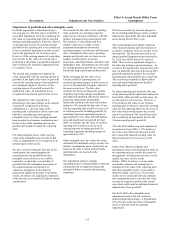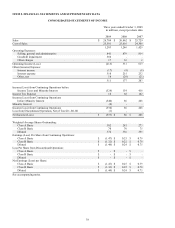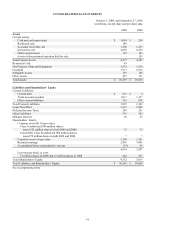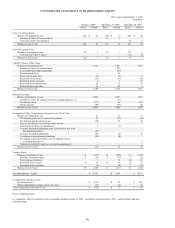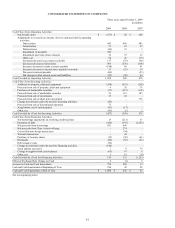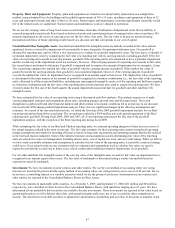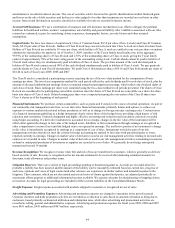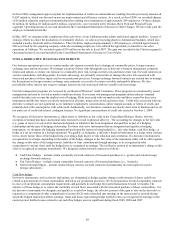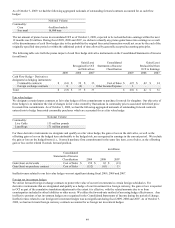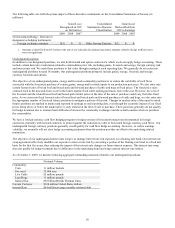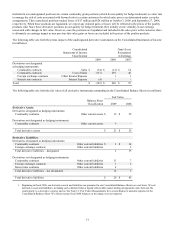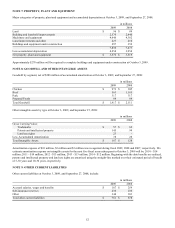Tyson Foods 2009 Annual Report Download - page 44
Download and view the complete annual report
Please find page 44 of the 2009 Tyson Foods annual report below. You can navigate through the pages in the report by either clicking on the pages listed below, or by using the keyword search tool below to find specific information within the annual report.44
amortization is recorded in interest income. The cost of securities sold is based on the specific identification method. Realized gains
and losses on the sale of debt securities and declines in value judged to be other than temporary are recorded on a net basis in other
income. Interest and dividends on securities classified as available-for-sale are recorded in interest income.
Accrued Self Insurance: We use a combination of insurance and self-insurance mechanisms in an effort to mitigate the potential
liabilities for health and welfare, workers’ compensation, auto liability and general liability risks. Liabilities associated with our risks
retained are estimated, in part, by considering claims experience, demographic factors, severity factors and other actuarial
assumptions.
Capital Stock: We have two classes of capital stock, Class A Common Stock, $0.10 par value (Class A stock) and Class B Common
Stock, $0.10 par value (Class B stock). Holders of Class B stock may convert such stock into Class A stock on a share-for-share basis.
Holders of Class B stock are entitled to 10 votes per share, while holders of Class A stock are entitled to one vote per share on matters
submitted to shareholders for approval. As of October 3, 2009, members of the Tyson family beneficially own, in the aggregate,
99.97% of the outstanding shares of Class B stock and 2.36% of the outstanding shares of Class A stock, giving the Tyson family
control of approximately 70% of the total voting power of the outstanding voting stock. Cash dividends cannot be paid to holders of
Class B stock unless they are simultaneously paid to holders of Class A stock. The per share amount of the cash dividend paid to
holders of Class B stock cannot exceed 90% of the cash dividend simultaneously paid to holders of Class A stock. We pay quarterly
cash dividends to Class A and Class B shareholders. We paid Class A dividends per share of $0.16 and Class B dividends per share of
$0.144 in each of fiscal years 2009, 2008 and 2007.
The Class B stock is considered a participating security requiring the use of the two-class method for the computation of basic
earnings per share. The two-class computation method for each period reflects the cash dividends paid for each class of stock, plus the
amount of allocated undistributed earnings (losses) computed using the participation percentage, which reflects the dividend rights of
each class of stock. Basic earnings per share were computed using the two-class method for all periods presented. The shares of Class
B stock are considered to be participating convertible securities since the shares of Class B stock are convertible on a share-for-share
basis into shares of Class A stock. Diluted earnings per share were computed assuming the conversion of the Class B shares into
Class A shares as of the beginning of each period.
Financial Instruments: We purchase certain commodities, such as grains and livestock in the course of normal operations. As part of
our commodity risk management activities, we use derivative financial instruments, primarily futures and options, to reduce our
exposure to various market risks related to these purchases, as well as to changes in foreign currency exchange rates. Contract terms
of a financial instrument qualifying as a hedge instrument closely mirror those of the hedged item, providing a high degree of risk
reduction and correlation. Contracts designated and highly effective at meeting risk reduction and correlation criteria are recorded
using hedge accounting. If a derivative instrument is accounted for as a hedge, changes in the fair value of the instrument will be
offset either against the change in fair value of the hedged assets, liabilities or firm commitments through earnings or recognized in
other comprehensive income (loss) until the hedged item is recognized in earnings. The ineffective portion of an instrument’s change
in fair value is immediately recognized in earnings as a component of cost of sales. Instruments we hold as part of our risk
management activities that do not meet the criteria for hedge accounting are marked to fair value with unrealized gains or losses
reported currently in earnings. Changes in market value of derivatives used in our risk management activities relating to forward sales
contracts are recorded in sales. Changes in market value of derivatives used in our risk management activities surrounding inventories
on hand or anticipated purchases of inventories or supplies are recorded in cost of sales. We generally do not hedge anticipated
transactions beyond 18 months.
Revenue Recognition: We recognize revenue when title and risk of loss are transferred to customers, which is generally on delivery
based on terms of sale. Revenue is recognized as the net amount estimated to be received after deducting estimated amounts for
discounts, trade allowances and product terms.
Litigation Reserves: There are a variety of legal proceedings pending or threatened against us. Accruals are recorded when it is
probable a liability has been incurred and the amount of the liability can be reasonably estimated based on current law, progress of
each case, opinions and views of legal counsel and other advisers, our experience in similar matters and intended response to the
litigation. These amounts, which are not discounted and are exclusive of claims against third parties, are adjusted periodically as
assessment efforts progress or additional information becomes available. We expense amounts for administering or litigating claims
as incurred. Accruals for legal proceedings are included in Other current liabilities in the Consolidated Balance Sheets.
Freight Expense: Freight expense associated with products shipped to customers is recognized in cost of sales.
Advertising and Promotion Expenses: Advertising and promotion expenses are charged to operations in the period incurred.
Customer incentive and trade promotion activities are recorded as a reduction to sales based on amounts estimated as being due to
customers, based primarily on historical utilization and redemption rates, while other advertising and promotional activities are
recorded as selling, general and administrative expenses. Advertising and promotion expenses for fiscal years 2009, 2008 and 2007
were $491 million, $495 million and $467 million, respectively.



